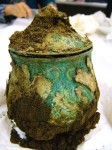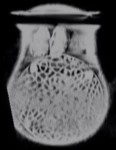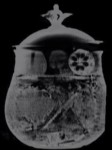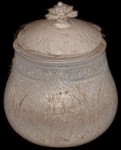 The Carolingian pot that was part of a Viking hoard discovered by metal detectorist Derek McLennan in Dumfries and Galloway, Scotland, last September has been CT scanned in a hospital. The silver alloy vessel is covered in verdigris (the green powdery substance produced from the corrosion of copper) and experts were concerned that it was too fragile to just take off the lid and dig out its contents blind. Richard Welander, Historic Scotland’s head of collections, contacted Dr. John Reid, a radiographer at Borders General Hospital and avid amateur archaeologist who had previously collaborated with Historic Scotland to scan the remains of a Roman soldier’s head discovered at the Trimontium fort in Newstead.
The Carolingian pot that was part of a Viking hoard discovered by metal detectorist Derek McLennan in Dumfries and Galloway, Scotland, last September has been CT scanned in a hospital. The silver alloy vessel is covered in verdigris (the green powdery substance produced from the corrosion of copper) and experts were concerned that it was too fragile to just take off the lid and dig out its contents blind. Richard Welander, Historic Scotland’s head of collections, contacted Dr. John Reid, a radiographer at Borders General Hospital and avid amateur archaeologist who had previously collaborated with Historic Scotland to scan the remains of a Roman soldier’s head discovered at the Trimontium fort in Newstead.
 Dr. Reid secured permission from hospital chief Calum Campbell for the £485,000 CT scanner to be used on the pot. So as not to interfere with the machine’s normal operations on actual human beings, the vessel was brought in the evening and was scanned. Derek McLennan and Richard Welander were present to witness the pot’s innards scanned in 120 visual slices accurate to within a half a millimeter.
Dr. Reid secured permission from hospital chief Calum Campbell for the £485,000 CT scanner to be used on the pot. So as not to interfere with the machine’s normal operations on actual human beings, the vessel was brought in the evening and was scanned. Derek McLennan and Richard Welander were present to witness the pot’s innards scanned in 120 visual slices accurate to within a half a millimeter.
 At first glance, one view revealed the presence of an Anglo-Saxon openwork brooch, a 9th century style seen in several pieces from the Pentney Hoard, now in the British Museum. Further examination of the CT scan results identified four other silver brooches, some gold ingots and ivory beads coated in gold. The contents are all wrapped in an organic material of some kind, possibly leather.
At first glance, one view revealed the presence of an Anglo-Saxon openwork brooch, a 9th century style seen in several pieces from the Pentney Hoard, now in the British Museum. Further examination of the CT scan results identified four other silver brooches, some gold ingots and ivory beads coated in gold. The contents are all wrapped in an organic material of some kind, possibly leather.
Now that they know the layout of the contents, conservators will be able to remove the contents in a controlled way.
Richard Welander, head of collections with Historic Scotland, said: “When I saw the results I was reminded of the words of Sir Howard Carter when Tutankhamen’s tomb was opened in 1922 – “I see wonderful things”.
“We are all so grateful to the Borders General Hospital for allowing us to forensically examine one of the key objects of the hoard.
“As with human patients, we need to investigate in a non-invasive way before moving onto delicate surgery.
“In this case, that will be the careful removal of the contents and the all-important conservation of these items.”
 The wrapping is going to make it a particularly challenging mission since it could easily fall apart the minute it’s exposed to air or interfered with in any way. I hope they film the surgery like they did the CT scan (see video below) because it’s sure to be fascinating.
The wrapping is going to make it a particularly challenging mission since it could easily fall apart the minute it’s exposed to air or interfered with in any way. I hope they film the surgery like they did the CT scan (see video below) because it’s sure to be fascinating.
 The scan also revealed more detail of the decoration on the exterior of the pot which is partially obscured by mud and a textile of some kind (no word yet on what that is). It’s that decoration that identifies the pot as Carolingian in origin, created between 780 and 900 A.D. It is a very rare discovery in Britain — only three, including this one, have ever been found — and this one is complete with its original lid still attached.
The scan also revealed more detail of the decoration on the exterior of the pot which is partially obscured by mud and a textile of some kind (no word yet on what that is). It’s that decoration that identifies the pot as Carolingian in origin, created between 780 and 900 A.D. It is a very rare discovery in Britain — only three, including this one, have ever been found — and this one is complete with its original lid still attached.
[youtube=http://youtu.be/AJReFq3g0z0&w=430]